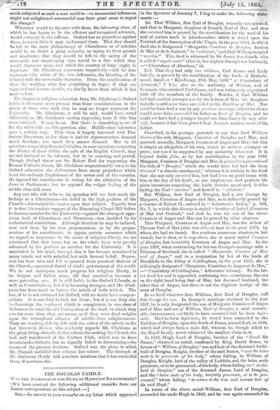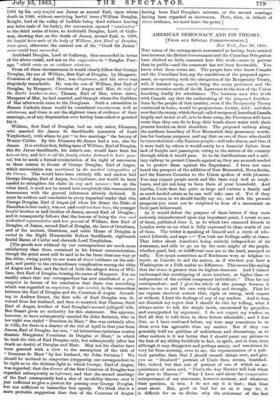THE DOUGLAS FAMILY.
WAS THE ANCESTOR OF THE DUKE OF HAMILTON ILLEGITIMATE ? [WE have received the following additional remarks from our former correspondent on this subject
SIR,—In answer to your remarks on my letter which appeared in the Spectator of January 7, I beg to make the folios in state- ments: 1st. That William, first Earl of Douglas, was only once married, and that to Margaret, daughter of Donald, Earl of Mar, and that she survived him is proved by the mortification for the weal of his soul of certain lands in Aberdeenshire which is dated upon the Festival of the Assumption of the Virgin, in the year 1384, in which deed she is designated "Margarita Comitissa de Douglas, doming de Mar et de le Garioch," in "vidaitate,"and Earl William is styled " maritus." This deed is witnessed by Sir James Sandilands, who is called " nepoti nostri" (that is, her nephew through her husband), —" Chartulary of Aberdeen," 44.
2nd. That they had only two children, Earl James and Lady Isabella, is proved by the mortification of the lands of Kinlach- muud, dated at " Kyndromy, 27th May, 1403 " ('• Chartulary of Arbroath," 7 b.); also on the authority of Winton, and of Froissart, who survived Earl James, and was intimately acquainted with all the members of the family. Besides, if Earl William had had another younger son by the heiress of Mar, his daughter Isabella would never have succeeded to the Earldom of Mar. Nor could he have had a son by any previous marriage, otherwise James would never have succeeded his father as Earl of Douglas, and he could not have had a younger lawful son than James by any other wife, because it has been proved that James's mother survived his- father.
Crawfurd, in his peerage, pretends to say that Earl William divorced his wife Margaret, Countess of Douglas and Mar, and? married, secondly, Margaret, Countess of Angus and Mar; but this is simply an allegation of his own, which he neither attempts to prove, nor can it be supported by any authority whatever. It is beyond doubt false, as by her mortification in the year 1384 Margaret, Countess of Douglas and Mar, is proved to have retained the title of "Douglas," which she would have lost had she been divorced " a vinculo matrimonii," whereas it is evident in the deed that she not only survived him, but had been on good terms with him to the day of his death, as she implements and perfects his. pious intentions respecting the lands therein mentioned, besides. stylingthe Earl " marlins " and herself in " yideitate."
But William, first Earl of Douglas, had a son George by Countess of Angus and Mar, as is indirectly proved by a charter of Robert II., entered in " Robertson's Index," p. 139, No. 7, in -which this George is styled " brother of Isabel, Countess; of Mar and Garioch," and that he was the son of the above- Countess of Angus and Mar can be proved by other charters.
This Margaret, Countess of Angus and Mar, was the widow of Thomas Earl of Mar (who was alive at least in the year 1378, by whom she had no issue). She confirms numerous charters to her vassals, but in them, or in any others, she is never styled Countess of Douglas, but invariably Countess of Angus and Mar. In the- year 1397, when contracting for her son George's marriage with a. Princess of Scotland, she is called " Margarate, Countas of Mar- and of _Angus," and in a resignation by her of the lands of Brockhole to the Abbey of Coldingham, in the year 1415, she is. still simply designated "Margareta, Comitissa de Angus et de Mar,' —" Chartulary of Coldingham," Advocates' Library. To the lat- ter deed her seal is appended, containing two escutcheons, the one- on the right hand being that of Mar, her deceased husband, the other that of Angus, but there is not the slightest vestige of the arms of Douglas.
In no deed whatever does William, first Earl of Douglas, calf this George his son. In George's marriage contract in the year 1397, he is only designated the son of Margtret. Countess of Angus. and of Mar, and not of William, Earl of Douglas, a most remark- able circumstance, not likely to have occurred had he been legiti- mate. Had he been legitimate, he would have succeeded to the Earldom of Douglas, upon the death of James, second Earl, in 1388, which had always been a male fief, whereas he, though allied to. the Royal family, never advanced the smallest claim to it.
In 1342, Hugh, Lord of Douglas, brother of the " Good Sir- James," obtained an entail, confirmed by King David Bruce, in of " William of Douglas," son and heir of the deceased Archi- bald of Douglas, Knight, brother of the said James, " and the heirs- male to be procreate of his body," whom failing, to William of Douglas, Knight, lord of the valley of Leddale, and the heirs male procreate, or to be procreated, of his body, whom failing, to" Archi- bald de Douglas," son of the deceased James, Lord of Douglas, and the "heirs male of his body, lawfully procreate, or to be pro- created," whom failing, " to return to the true and nearest heir of' the said Hugh."
In terms of the above entail William, first Earl of Douglas,. succeeded his uncle Hugh in 1343, and he was again succeeded iia 1384 by, is only lawful son James as second Earl, upon whose death it 1388, without surviving lawful issue (William Douglas, Knigfit, lord of the valley of Leddale being dead without leaving
any heirs male of his body), the succession opened "nomination " to the third series of heirs, to Archibald Douglas, Lord of Gallo-
way, showing that on the death of James, second Earl, in 1388, the lawful heirs male of the body of William, first Earl of Douglas, were spent, otherwise the natural son of the " Good Sir James " never could have succeeded.
Archibald Douglas, Lord of Galloway, thus succeeded in terms of the above entail, and not on the supposition in " Douglas Peer- age, " which rests on no evidence whatever.
From all these circumstances it would clearly follow that George Douglas, the son of William, first Earl of Douglas, by Margaret, Countess of Angus and Mar, was illegitimate, and his status was singularly remarkable. He was the son of William, first Earl of Douglas, by Margaret, Countess of Angus and Mar, the wife of the Earl's brother-in-law, Thomas, Earl of Mar, whose sister, Margaret of Mar, he had married, and through whom the Earldom of Mar afterwards came to the Douglases. Such a connection in Roman Catholic times would be considered incestuous as well as adulterous, and there is not the slightest trace of evidence of their marriage, or of any dispensation ever having been asked or granted for it.
William, first Earl of Douglas, had an only sister, Eleanora, who married Sir James de Sandilandis (ancestor of Lord Torphichen), with whom he got " in free marriage " the barony of Wester Calder. By this Eleanora Sir James had a son, also Sir James. It is evident that, failing issue of William, Earl of Douglas, this Sir James Sandilands, his sister's son, would have been his heir-at-law, and heir to all the family estates destined to heirs gene- ral, but he made a formal renunciation of his right of succession to these estates in favour of George Douglas, Earl of Angus, which renunciation was sanctioned by the marked interposition of the Crown. This would have been entirely idle and useless had George Douglas, Earl of Angus, been legitimate, nor would he have needed to strengthen his claim in any such manner ; but on the other hand, it need not be stated how completely this renunciation harmonizes with the general inferences already deduced. It must be evident and conclusive to every impartial reader that this George Douglas, Earl of Angus (of whom his Grace the Duke of Hamilton is heir male), was not, and could not have been, the younger lawful brother or half-brother of James, second Earl of Douglas ; and it consequently follows that the honour of being the true and undoubted representative and heir general of William, first Earl of Douglas, of James, second Earl of Douglas, the hero of Otterburn, and of the ancient, illustrious, and noble House of Douglas, is vested in the Right Honourable Robert Sandilands, eighteenth feudal Baron of Calder and eleventh Lord Torphichen.
[The proofs now adduced by our correspondent are much more satisfactory than those contained in his former communication, though the point must still be said to be far from clear one way or the other, owing partly to our want of direct evidence on the sub- ject, and partly to the extraordinary complication among the titles of Angus and Mar, and the fact of both the alleged wives of Wil-
liam, first Earl of Douglas, bearing the name of Margaret. Yet we readily admit that our correspondent has now established a pre-
sumption in favour of his conclusion that there was something which was regarded as suspicious, if not invalid, in the connection between the Earl of Douglas and the Countess of Angus. Accord- ing to Andrew Stuart, the first wife of Earl Douglas was di- vorced from her husband, and then re-married, first Thomas, third Earl of Angus, brother of Earl Douglas's second (alleged) wife. But Stuart gives no authority for this statement. She appears, however, to have subsequently married Sir John Swinton, who in her right was styled "Dominus de Marr." She was certainly alive in 1385, for there is a charter of the 3rd of April in that year from James, Earl of Douglas, her son, " ad instantiam carissimas nostrte domim Margaretm Comities de Douglas et Marr," in which he took the title of Earl Douglas only, but subsequently (after her death no doubt) of Douglas and Marr. May not his charter have been granted with a view to the assumption of the title of "Dominus de Marr" by her husband, Sir John Swinton? We should be inclined to conjecture (supposing our correspondent to be right as to the dubious light in which George, Earl of Angus, was regarded) that the divorce of the first Countess of Douglas was regarded subsequently as informal, and that the second marriage of the Earl consequently had a slur of invalidity thrown over it just sufficient to give a pretext for passing over George Douglas, but not sufficient to bastardize him openly. We think this is a more probable suggestion than that of the Countess of Angus having been Earl Douglas's mistress, or the second marriage having been regarded as incestuous. Here, then, in default of direct evidence, we must leave the point.]































 Previous page
Previous page